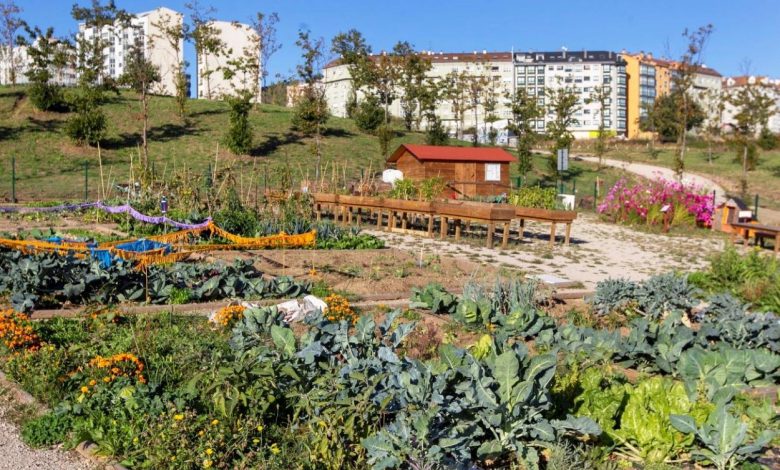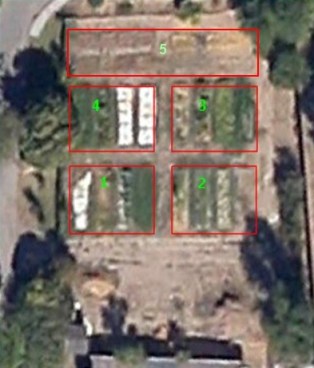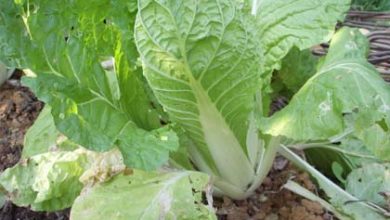Ecological Garden in Agrónomos – The ETSIA and its ecological initiatives

Another article on ecological initiatives at the School of Agricultural Engineers in Madrid!
In this case it is the Ecological Garden.It is located in the practice fields of the School, next to the Senda del Rey, just 50 meters from the Aula Verde Invernadero Botánico that we talked about in another post.
The garden was launched in 2006 thanks to the Educational Innovation Group «Ecological Agriculture» of the ETSIA , and is currently directed by Professor Pilar López de Fuentes, from the Department of Chemistry and Agricultural Analysis, who kindly lent me their help in telling the readers of Agrohuerto what is done in this organic garden in the city of Madrid.
The maintenance, care and study of the orchard are in charge of the teachers, students and staff of the fields of practice interested in Agroecology, organic horticulture, research or carrying out recreational, training activities… Interest in Ecological Agriculture and Nature Urbana is evident in the School, and many of them participated in the Conference on Green Cities in the World held on April 4.

The ecological garden in Agrónomos was established with a didactic purpose, to disseminate different forms of Ecological Agriculture cultivation (weeding techniques, pest and disease management, fertilization, etc.) that use agroecological currents such as Biodynamics, and to promote the consumption of quality products and make known all the benefits of organic food.
The garden has also been used to carry out practical classes on different subjects taught at the School, and to carry out tests on some lines of research in the School’s departments: in the garden, for example, analyzes of soils, studies on the behavior of water in the soil, on weeds, biosolarization, biofumigation, covers, on the behavior of crops in different types of soil, etc.
Ecological garden in Agrónomos How is it organized?
The plot has approximately 800 m2 and, of them, almost 200 m2 are cultivated.
Garden limits: the vegetable screen
The location of the plot is not arbitrary, and, according to what Professor Pilar López de Fuentes told me, when the orchard was installed, it was sought that it be as protected as possible, in order to preserve it from the action of hypothetical harmful and harmful agents, such as extreme temperatures or pollution. For this reason, an area limited by trees was chosen and the «vegetable screen» was completed by planting shrub species such as laurel, honeysuckle, strawberry tree, broom, etc.
The growing area

As you can see in the image, the garden is divided into five zones. The first four are dedicated, each one of them, to a different «school», system or method of cultivation:
- Zone 1: Biodynamic Agriculture.
- Zone 2: Deep Terrace.
- Zone 3: Mediterranean or Semi-deep terrace.
- Zone 4: Parades in Crestall.
Each of these sectors has 4 terraces that are cultivated in a four-year rotation (each group of crops «repeats terraces» every four years). As we explained in the post on Crop rotation, there are several aspects that can be taken into account when making the groups of plants that will be grown in each plot. In this case, the distribution of zones 1 and 2 is made according to the organ of use of the vegetables (fruit, leaf, root…) and that of zones 3 and 4 according to the demands or requirements of the crops.
Zone 5 is a “free zone” (not subject to rotation). It may be occupied by multi-annual organic crops, without following the rules established by a specific agroecological school. When necessary, it is also used to house leftover plant material if, for example, more plants have germinated in the seedbeds than fit in the terraces, or for practices and other ETSIA teaching activities. In addition, if other teachers or departments of the School require it, these areas have also been used for tests or research.
The composting area
The orchard is mainly fertilized with compost. A part is prepared on the farm itself, so there is an area for composting.
That same area is also dedicated to the preparation of natural insecticides, such as nettle slurry (which we already talked about in the article Aphids, how can we control them).
In the photo below, in the background, the area where the compost is produced (in a heap and in a small plastic composter, on the left) and the preparations, which are in metal containers and covered by plastic, can be distinguished quite well. There is also a covered area to protect the straw bales that will be used for the covers

The seedbed area
A few meters from the organic garden there is a small “nursery cabin” where the seeds are germinated and the seedlings are cared for, which, when they are sufficiently grown, are planted in the garden.

In the following article » Ecological management in the garden of the School of Agronomists» we give more details about the techniques followed in this organic garden!
I hope you liked knowing another experience of Organic Agriculture in the city



![Photo of The Callisia Repens: [Planting, Care, Irrigation and Substrate]](https://www.complete-gardening.com/wp-content/uploads/2021/06/repens_1568322462-390x220.jpg)
![Photo of Kumato Tomato: [Sowing, Care, Irrigation, Substrate and Pests]](https://www.complete-gardening.com/wp-content/uploads/2021/06/Solanum_Lycopersicum_1591645137-390x220.png)